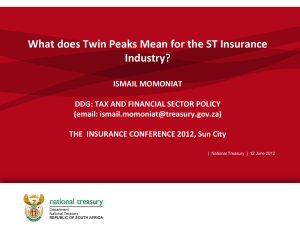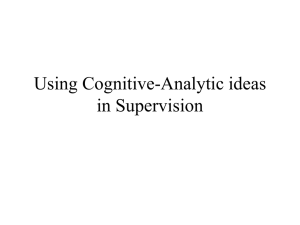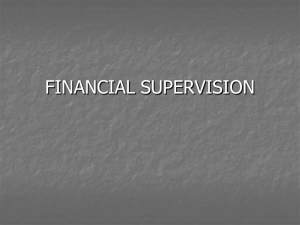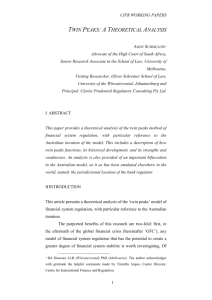Twin Peaks
advertisement
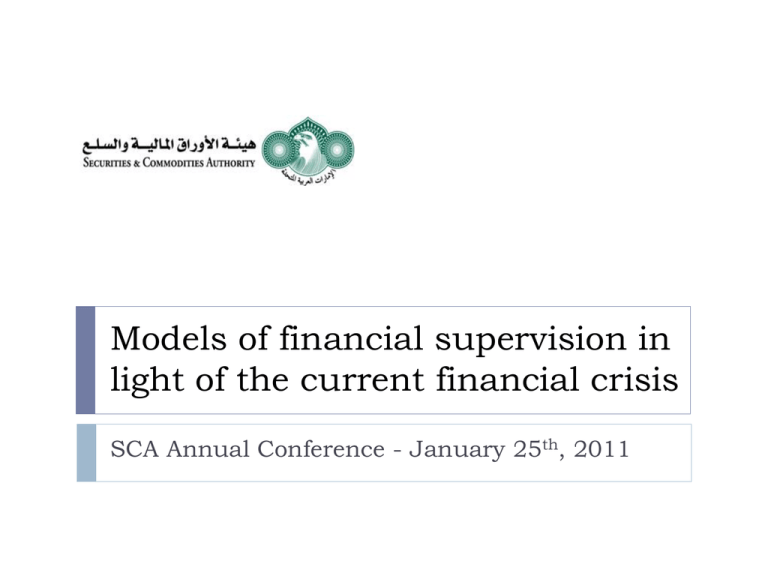
Models of financial supervision in light of the current financial crisis SCA Annual Conference - January 25th, 2011 International trend towards supervision 1971 1985 1987 Norway 1988 1992 1999 2000 Denmark 2002 2004 2006 Austria Germany Estonia Australia Iceland Ireland Canada Singapore Sweden 2 2003 UK Japan Hungary Czech R. Slovakia Belgium Netherlands AFM: CONDUCT DNB: PRUDENTIAL Key approaches to supervision Approaches Institutional China, Hong Kong, and Mexico Functional Brazil, France, Italy, and Spain Integrated Singapore, and Switzerland Twin Peaks Netherlands, and Australia Unique USA 3 Defined Approach in which a firm’s legal status (for example, a bank, brokerdealer, or insurance company) determines which regulator is tasked with overseeing its activity from both a safety and soundness and a business conduct perspective. Approach is one in which supervisory oversight is determined by the business that is being transacted by the entity, without regard to its legal status. Each type of business may have its own functional regulator. Approach is one in which a single universal regulator conducts both safety and soundness oversight and conduct-of-business regulation or all the sectors of financial services business. a form of regulation by objective, is one in which there is a separation of regulatory functions between two regulators: one that performs the safety and soundness supervision function and the other that focuses on conduct-of-business regulation. Functional and institutional mixture Global supervisory regimes - Before & After Country Before current crisis Moving towards …….. USA Functional/Institutional Twin Peaks/ Integrated mix UK Integrated tripartite Twin Peaks Holland Twin Peaks No change Italy Functional Twin Peaks Spain Functional Twin Peak France Functional Twin Peaks Canada Integrated/Twin Peaks No change Singapore Integrated No change 4 Prudential & Conduct of Business supervision integrated? yes yes Integrated with Central Bank? “One Peak” Singapore, Switzerland no “Twin Peaks” The Netherlands Germany, Austria no “FSA” UK, Japan, Canada Scandinavia, Belgium and more “Three Peaks” Australia Institutional ............................. Functional? 5 Moving towards a Twin Peaks Model Banking Securities Insurance Conduct supervision Conduct supervision Conduct supervision Prudential supervision Prudential supervision Prudential supervision Lender Of Last Resort Systemic Stability Prudential Supervision 6 Systemic Stability Lender Of Last Resort Market Conduct Supervision Conduct-of- Business Supervision Group of Thirty, Washington, DC 2008 The structure of Financial Supervision Approaches and Challenges in a Global Marketplace: 7 USA – Functional & Institutional model The US financial and regulatory system is the global exception to the rule. It does not fall within any specific structure but is a combination of functional and institutional models. The key bodies are the FRB, SEC, CFTC, OCC, FDIC, OTS, NCUA, FHLBB, FINRA, FFIEC, state regulators….. CHANGES: Dodd-Frank Act of July, 2010 creates an improved framework for identifying and mitigating systemic risk 8 Includes a more effective approach to prudential regulations as well as consumer protection USA – Functional & Institutional cont’d The Act creates new systemic risk regulation rules: Financial Stability Oversight Council (FSOC) Investor protection & new regulation of securities rules Bureau of Consumer Financial Protection (BCFP). New orderly liquidation authority rules Federal Deposit Insurance Corporation (FDIC) New Bankruptcy and Insolvency Codes The Volcker Rules By prohibiting proprietary trading by banks and financial institutions Re-regulation of derivatives markets Minimum leverage & risk-based capital requirements 9 UK – Integrated model Traditionally the FSA has had all-encompassing powers to oversee the conduct of business and microprudential regulation with the BOE having macroprudential regulatory authority. CHANGES: The regulatory framework will move towards a twin peak like model. The FSA will cease to exist in its current form. In its place, the government intends to establish the following new entities between now and the end of 2012: 10 Prudential Regulation Authority (PRA)— will be responsible for the prudential regulation of financial firms. Consumer Protection and Markets Authority (CPMA)— will regulate firms providing financial services to consumers. Financial Policy Committee (FPC)— will have responsibility for macro issues potentially affecting economic and financial stability. Economic Crime Agency (ECA)—will prosecute economic and financial crimes. Supervisory landscape in the UK Financial stability Macroprudential Microprudential Conduct Of Business Banks Insurance Companies FPC PRA CPMA Securities firms PRA = Prudential Regulation Authority; CPMA = Consumer Protection and Markets Authority (CPMA); FPC = Financial Policy Committee 11 Holland – Twin Peak model The Central Bank of Netherlands (DNB) was responsible for Macroprudential (systemic stability). Microprudential and conduct of business were under a few other regulatory bodies. CHANGES: The Twin Peaks approach was developed in 2004 and was improved after the crisis by the DNB initiating key structural changes: 12 Improved financial institutions risk analysis to help identify key risks Open and communicative strategy with the government and with the AFM. The Council for Financial Supervisors (RFT) has also been created in order to ensure the seamless exchange of information between regulatory stakeholders. Supervisory landscape in Holland 13 Australia – Three Peaks model A strict”twin peaks” like approach has been followed where supervision is organized along the following tracks: 14 Prudential supervision for all firms (banks, investment firms, insurance, and pension funds) is exercised by APRA, the Australian Prudential Regulation Authority. Market supervision aimed at market integrity and consumer protection is in the hands of ASIC, the Australian Securities and Investments Reserve Bank of Australia (RBA) oversees systemic stability, predominantly through its influence over monetary policy, The Australian Competition and Consumer Commission (ACCC) regulates anti-competitive behavior. France – Functional model Functional approach with some elements of a twin peaks model although it is still greatly fractured with far too many regulatory bodies. Regulation and surveillance of the French financial markets are exercised by two authorities: the Banque de France and the Autorité des Marchés Financiers (Financial Markets Authority) with several other sub-authorities. Insurance activities in France are supervised by a separate insurance regulator, the Insurance and Mutual Societies Supervisory Authority (ACAM) CHANGE: A new Banking & Financial Regulation Law 2010 has been passed to strengthen the French capital markets. 15 France – Twin Peaks like model The Financial and Banking Regulation Law (Loi de Régulation Bancaire et Financière) of October 22, 2010 contains six main measures: 16 (1) creation of the Council of Financial Regulation and Systemic Risk (Conseil de Régulation Financière et du Risque Systémique—the "Council"); (2) enhancement of the powers of the Financial Markets Authority the "AMF”- to include conduct of business and consumer protection authorities, (3) The Law ratifies the creation of the Prudential Control Authority, in January 2010 of the French entity called Autorité de Controle Prudentiel and makes some changes to its system; (4) regulation of derivative instruments and short sales; (5) regulation of credit rating agencies; and (6) reinforcement of the regulation of providers of financial products and services. Singapore - Integrated Singapore has an integrated financial regulatory structure The Monetary Authority of Singapore (MAS) has the authority to regulate the banking, securities, futures, and insurance industries in the nation-state. CHANGE: The Securities and Futures (Amendment) Act 2009 was passed to amend the Securities and Futures Act 17 MAS issued a consultation paper in 2010 to propose amendments to the Securities and Futures (Offers of Investments) (Shares and Debentures) Regulations 2005 ("SFR"). Other than that, currently, there is no significant debate on regulatory structure. Key benefits of Twin Peak model Regulation by Objective 18 One agency’s regulatory objective is (Macro + Micro) prudential supervision with the primary goal of safety and soundness and The second agency’s goal is to focus primarily on business conduct and consumer protection issues. Benefits, according to the G30 Report the prudential supervisor may give precedence to safety and soundness, over CoB and Consumer protection. TP will help prevent that. Twin Peaks may also be the optimal means of ensuring that issues of transparency, market integrity, and consumer protection receive sufficient priority. a means of achieving the benefits of the Integrated Approach with the added distinct emphasis on consumer protection issues, particularly for retail customers. each regulator can hire employees with appropriate expertise for their specific functions. Prudential regulators employ business & economic expertise while business conduct regulators focus on hiring enforcement oriented staffs. Having the functions in separate entities can minimize the conflicts between the dissimilar disciplines. It is the new direction of many world economies as a response to the current crisis. Australia and the Netherlands before and US, UK, Spain, Italy and France to name a few. 19 According to the IMF report on The Netherlands released 12/14/2010. 20 Netherlands has over the past decade introduced a financial sector supervisory model that is being studied closely in many countries. The “twin peaks” model of supervision provided additional strengths, perhaps not foreseen at the outset, but have become evident, DNB has the ability to take a systemic view across the financial sector as a whole, and the ability to react quickly and decisively. The credibility of the prudential authorities has been tested. The allocation of the prudential function to DNB was important to restore credibility. The supervision of Netherlands banks by DNB has achieved a high level of compliance. AFM uses onsite-supervision, complemented with an institution-based program of both off-site and on-site supervision of high-impact firms. The coordinated response of the Ministry of Finance , DNB, and AFM during the crisis proved effective in handling an unprecedented situation. Overall the Netherlands has developed a robust supervisory framework that exhibits high levels of implementation of the IOSCO Principles. The way forward Need for change – increasing demand on supervisors effectiveness and accountability Interwoven regulatory financial supervision with no clear boundaries is a major concern Separation of prudential/systemic from Conduct-ofbusiness and consumer protection is called for Independence of supervisors is recognized to be an essential element for effective supervision. provide regulators with legal protection for their official actions as institutions. Checks and balances can be achieved by having each of the two regulators (peaks) report to two different ministries. 21 Proposed supervisory model Minister of Economy Prudential & Systemic Central Bank Conduct of business Consumer protection Securities Regulators Independent under 2 separate roofs – checks and balances Prudential & systemic regulation under the Central Bank Regulation of the securities markets, COB and consumer protection under the Securities regulator 22 Minister of Finance Development of a detailed execution plan including milestones Time and care given to implementation of the plan Possible time-line for execution phase 1 Jun 2011 6 months Dec 2011 Strategy: • Formulate strategy • and logic • Identify synergy targets • Determine main • new modes of operation • Develop criteria for the implementation • process • Develop new main organisational model 23 phase 2 12 months Planning: Dec. 2012 phase 3 6 months Jun 2013 Implementation phase 4 12 months Completion: • Implement Develop detailed • Implement organizational organizational structure of structure and structure, organisational processes processes, model • Monitor synergies stratigies, laws and Strategy and and cost savings regulations Operational plans, • Recruitment of • Monitor synergies Laws and speciliezed and use regulations personnel and replacement policy Monitoring training of existing • Resolve parameters and cadre outstanding issues processes • Develop plan of action for phase 4
